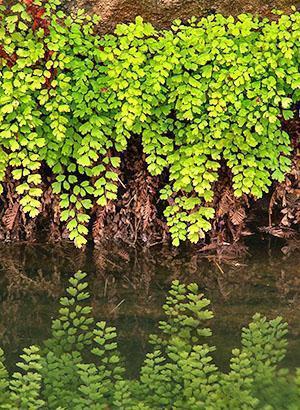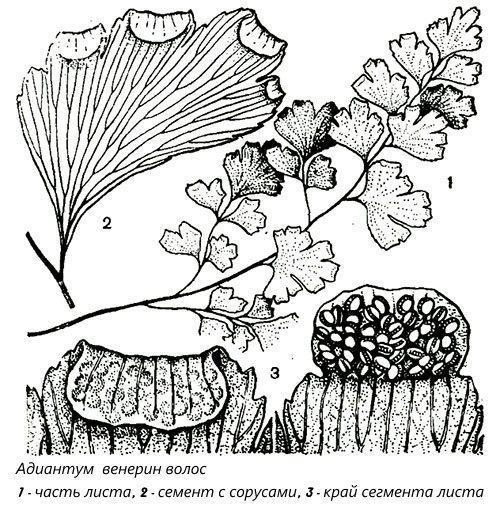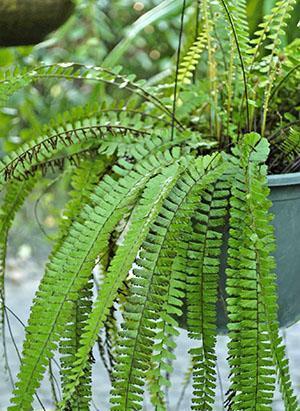We grow a beautiful maidenhair at home
 The genus of maidenhair, relatively small, living in the tropical and subtropical belt of the Earth of ferns, unites many independent genera. Some of them, for example, "hair Venus" and other varieties are very popular with indoor plant lovers.
The genus of maidenhair, relatively small, living in the tropical and subtropical belt of the Earth of ferns, unites many independent genera. Some of them, for example, "hair Venus" and other varieties are very popular with indoor plant lovers.
In nature, ferns of this genus live close to water bodies, on nutritious loose soils. Plants easily tolerate partial shade, and although the maidenhair are thermophilic, they negatively perceive the heat and dryness of the soil and air.
Despite the fact that ferns are not the easiest plants for home conditions, many flower growers are interested in the cultivation of maidenhair and caring for it. Indeed, the openwork greenery of the plant is worth spending a little time on creating the proper conditions for an unusual decorative leafy culture.
Creating conditions for growing maidenhair

Among the main conditions that need to be created for the fern is the level of lighting required by the plant, watering mode and top dressing, as well as a florist will have to choose a soil and a place with the proper temperature for the maidenhair.
Lighting for growing maidenhair
 The best place for a home-grown home-grown maidenhair is in partial shade. Therefore, the plant can be placed on a windowsill facing the northwest or east side. In summer, if the fern is exposed to direct sunlight, it is moved away from the window or covered with a translucent screen. Otherwise, the maidenhair that has stood in the sun will lose its brightness, its foliage will become faded, it may turn yellow or fade.
The best place for a home-grown home-grown maidenhair is in partial shade. Therefore, the plant can be placed on a windowsill facing the northwest or east side. In summer, if the fern is exposed to direct sunlight, it is moved away from the window or covered with a translucent screen. Otherwise, the maidenhair that has stood in the sun will lose its brightness, its foliage will become faded, it may turn yellow or fade.
At the same time, even in full shade, one should not expect that the fern will delight with emerald greenery. Particular attention to the condition of the plant is necessary when changing seasons, when daylight hours are shortened or lengthened. However, without good reason, it is better not to change the location of the capricious maidenhair in this respect.
If at home caring for the maidenhair, as in the photo, meets the requirements of the plant, then the fern responds with good growth, the appearance of new leaves and a long life of old ones.
Air temperature for maidenhair
 One of the most important conditions for the health of a green pet is maintaining an acceptable air temperature for it. In nature, the optimum temperature for the growth and development of the maidenhair does not exceed 20–26 ° C. When the dormant period begins, and the plant falls into a kind of hibernation, the air cools down to 15 ° C. If the conditions for growing the maidenhair at home coincide with natural conditions, the fern does not disturb the grower either with yellowing of the foliage, or the appearance of dark spots on it or the development of rot on the stems and the underground part of the plant.
One of the most important conditions for the health of a green pet is maintaining an acceptable air temperature for it. In nature, the optimum temperature for the growth and development of the maidenhair does not exceed 20–26 ° C. When the dormant period begins, and the plant falls into a kind of hibernation, the air cools down to 15 ° C. If the conditions for growing the maidenhair at home coincide with natural conditions, the fern does not disturb the grower either with yellowing of the foliage, or the appearance of dark spots on it or the development of rot on the stems and the underground part of the plant.
In addition to maintaining the temperature background, it is important to protect the maidenhair from drafts and hot air flows emanating from heating devices.
At the first signs of wilting due to hypothermia or, conversely, the action of the dry air of the room, the plant can be trimmed. It is better to cut off the damaged parts to the ground level, while the maidenhair, if taken care of, will quickly restore what was lost.
Watering and feeding plants
 When growing and caring for the maidenhair, the organization of watering the plant is very important. The fern has an extremely negative attitude to the drying out of the soil layer, where its rhizomes are located, but excessive soil moisture is also undesirable for the maidenhair. Therefore, it is best to establish regular, but moderate watering, carefully observing that between procedures the top layer of the substrate has time to dry out.
When growing and caring for the maidenhair, the organization of watering the plant is very important. The fern has an extremely negative attitude to the drying out of the soil layer, where its rhizomes are located, but excessive soil moisture is also undesirable for the maidenhair. Therefore, it is best to establish regular, but moderate watering, carefully observing that between procedures the top layer of the substrate has time to dry out.
Unlike many indoor plants, which are sensitive to the hardness of irrigation water with spots on the foliage, the maidenhair is more dependent on the presence of chlorine compounds in the moisture.
So that the plant does not lose its attractiveness, it is more correct to moisten the soil with settled water. And the owners of aquariums can water the fern with the water drained during the replacement:
- In the warm season, when the plant actively forms new leaves and grows, watering should be more frequent and abundant, for example, up to 2-3 times a week.
- During hibernation, from mid-autumn to spring, you can water the fern once a week.
 Home-grown maidens do not react well to a high concentration of dressings, therefore, it is better to apply all fertilizers applied from spring to autumn in a half dose. The frequency of feeding at this time is once every two weeks, and the formulations used should not include lime. No feeding is planned for the cold season.
Home-grown maidens do not react well to a high concentration of dressings, therefore, it is better to apply all fertilizers applied from spring to autumn in a half dose. The frequency of feeding at this time is once every two weeks, and the formulations used should not include lime. No feeding is planned for the cold season.
Air humidity for fern in apartment conditions
 At home, growing maidenhair is often difficult due to the excessive dryness of the room air. If the leaves on the fern begin to dry out, you need to urgently take measures to humidify the air next to the plant. To do this, use household appliances, improvised means, or the installation of a pot with an maidenhair in a pallet with wet expanded clay.
At home, growing maidenhair is often difficult due to the excessive dryness of the room air. If the leaves on the fern begin to dry out, you need to urgently take measures to humidify the air next to the plant. To do this, use household appliances, improvised means, or the installation of a pot with an maidenhair in a pallet with wet expanded clay.
In especially serious cases, for example, in the winter months, when it is not possible to move the pot out of the heated room, the maidenhair can be sprayed with warm water, having previously protected the soil from excess moisture.
If in a hot room the plant has lost almost all the leaves, you should not leave the pet. With proper care, the grown maidenhair will again become attractive and green. To do this, the pot is transferred to a room with a temperature of 18–20 ° C and watering of the bush is gradually started. If the fern roots are alive. The plant will soon respond with new foliage.
The optimum air humidity is 60–70%. Therefore, in the summer months, it is useful to take the plant out into the garden or on a closed terrace.
A video about caring for maidenhair at home reveals the intricacies of all stages and will help in practice to prevent mistakes that threaten plant diseases or weaken it due to an invasion of pests.
Planting and caring for the maidenhair at home
 In natural conditions, the maidenhair lives on small accumulations of soil, which is hammered between rocky ledges and on stony placers. In fact, a fern of this genus leads a lithophyte lifestyle, which means that at home you need to choose a similar soil for it and a suitable container.
In natural conditions, the maidenhair lives on small accumulations of soil, which is hammered between rocky ledges and on stony placers. In fact, a fern of this genus leads a lithophyte lifestyle, which means that at home you need to choose a similar soil for it and a suitable container.
The maidenhair pot should not be deep. Ferns have a shallow rhizome, so it is more important to provide space for growth in a wide container. At the bottom of the pot, a powerful drainage layer is required, and then a special soil for the maidenhair is poured.
The peculiarity of the soil intended for the maidenhair is that it should have a slightly acidic reaction, be well wetted with water, but not retain excess moisture.
The main requirement for the substrate is lightness, nutritional value and air permeability, therefore humus, perlite or vermiculite, peat and sand cleared of coarse inclusions, can become a component for it. It is useful to add crushed sphagnum, bark and charcoal to such a soil for maidenhair.When planting the maidenhair, as in the photo, and caring for the plant, it is important to ensure that the root collar does not end up under the substrate, otherwise its decay cannot be avoided.
The plant transplant carried out in the spring is used to divide the adult maidenhair, for which small parts of the rhizome with several healthy leaves are carefully cut off. It is better to separate the roots of future ferns from the edge, without disturbing the main lump with the main rhizome. Then the sections are sprinkled with charcoal powder and planted in fresh soil for the maidenhair.
Vegetative propagation at home makes it possible to quickly and without special knowledge get young maidenhair plants, which, after transplantation, are treated in the same way as for adult ferns.
I really like your program